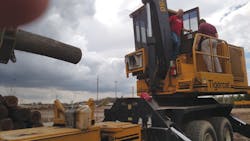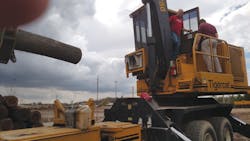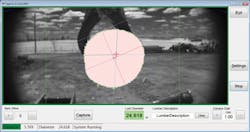Forestry automation: Vision system speeds log volume analysis
To remain competitive, lumber mill operators must accurately determine the amount of wood that is produced from their timber suppliers. In the lumber industry, this is determined by measuring the length and diameter of logs and then calculating how many one inch thick boards can be fabricated from them - a figure known as board feet measure.
After trees are felled, they are de-limbed and cut to a specific length after which the diameter of each one must be measured. "In the past," says Greg Hilbert, President of eSolutions (Lafayette, IN, USA; www.esolutionscompany.com), "measuring the diameter of each log was performed manually - a process that was labor intensive, time consuming and not consistently accurate.
Based on the success eSolutions had shown in the development of a vision-based wood trimming system, Pike Lumber (Akron, IN, USA; www.pikelumber.com) tasked Hilbert and his colleagues with the development of a vision-based system to automatically perform log diameter measurement. Mounted to the front of a Tigercat 240B loader from Tigercat Industries (Brantford, ON, Canada; www.tigercat.com), the system allows the operator to determine the diameter of each log and thus the board feet measure.
"This," says Hilbert, "allows a single operator to do the complete process of picking, placing and cutting logs to length and calculate the board feet measure without leaving the cabin of the loader. Without this system another person is required to manually perform log diameter measurement."
In operation, the operator first picks the tree-length log from a pile, processes it to a specific length and then positions it within the field of view of a Visionscape GigE camera from Microscan (Renton, WA, USA; www.microscan.com) that is housed in a rugged enclosure. To determine whether the log is within the field of view, two efector pmd laser sensors from ifm efector (Exton, PA, USA; www.ifm.com) are used to measure the distance of the log from the camera using the Time-of-Flight principle.
"Because the log may be slightly skewed with respect to the position of the camera," says Hilbert, "two measurements are taken by each laser sensor and their average used to determine the final distance measurement." Interfaced to a programmable logic controller (PLC), this distance measurement is then transferred over an RS232 serial interface to a host laptop PC located in the cabin of the loader.
As the system was required to operate in varied environmental conditions, the faces of the logs are illuminated by an XR256 Series IR strobe light from Smart Vision Lights (Muskegon, MI, USA; www.smartvisionlights.com). "By using this illumination system and an IR bandpass filter on the camera," says Hilbert, "it is possible to reduce the amount of ambient lighting captured by the camera. Using a 100ms strobe also eliminates any motion effects that may occur as the loader holds the timber in the field of view of the camera."
To allow the operator to control the system from the cabin of the loader, the laptop PC is interfaced to a USB 2-based multifunction DAQ terminal strip from Labjack (Lakewood, CO, USA; www.labjack.com) and in-turn to a push-button to activate the vision system. Once placed in the field of view of the vision system, the operator initiates the measurement, triggering the camera and strobe light.
Images from the camera are then transferred over the Gigabit Ethernet interface to the laptop PC. Once captured, the image is thresholded and blob analysis is performed using Microscan's Visionscape software.
"In doing so, much of the outside bark of the wood is eliminated from the image, providing the lumber company with a better estimate of board feet measure," says Hilbert. This software is then used to determine the center of the log and calculate its diameter in pixel values. This data is then used along with the distance measurements from the laser sensors and the perspective geometry of the camera to calculate the true width of the log. Once calculated the board feet measure is recorded and the log is sorted for transport to the lumber mill where it is then processed into lumber.



